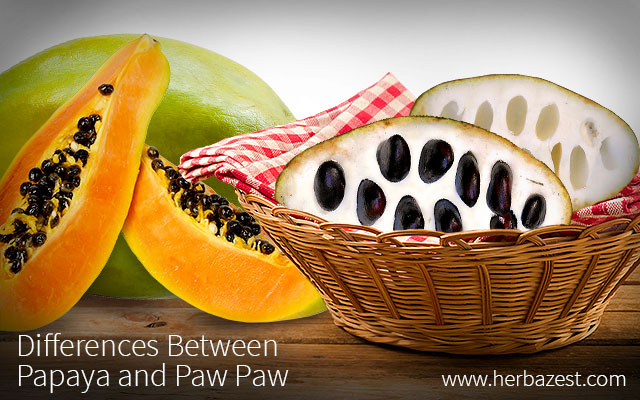The trouble with papaya and paw paw names seems to be a general lack of consistency. In the English dialects of Australia and New Zealand, for example, the term 'paw paw' refers to the common papaya fruit, most readily recognized by its orange and pink flesh, sweet flavor, and small, black papaya seeds.
In North American English, however, the fact that paw paw refers to a completely different plant altogether has been the source of much confusion. Luckily, a basic understanding of the difference between papaya and paw paw can be achieved through a brief but informative study of their individual characteristics.
Paw Paw and Papaya: Same Name, Different Species
The primary distinction that needs to be made between paw paw and papaya is that they are two gastronomically-similar fruits from very different botanical backgrounds. Native to the tropical regions of Central America, the papaya tree, Carica papaya, belongs to the small Caricaceae family. With white-petaled flowers and a roughened, dark green stem, it is a large herbaceous plant growing up to 30 feet (9 m) tall.
The ripe papaya fruit turns orange or deep yellow in color. While some are small and handheld, they usually resemble large, brightly-colored melons. With a subtly sweet flavor, papayas have been widely studied and selectively bred for the commercial market. They also contain the powerful enzyme papain, which is currently used in a number of cosmetics, food additives, and herbal supplements.
Meanwhile, paw paw, also called American custard apple, is a member of the Annonaceae family and it is known botanically as Asimina triloba. This small, deciduous tree, 16 - 40 feet (5 - 12 m) tall, is native to the eastern regions of North America, where it is well suited to the temperate climate.
WHILE COLD TEMPERATURES SEVERELY THREATEN THE SURVIVAL OF THE PAPAYA PLANT, PAW PAW TREES REQUIRE AT LEAST 100 HOURS OF FROST FOR A GOOD QUALITY YIELD.
Deep purple and goblet-shaped, paw paw flowers are no less ornamental than those of the fragrant papaya tree. With a similar tropical look, their resulting fruits resemble oblong, dusty-green or brownish mangos with large, bean-shaped black seeds. Significantly smaller than most papaya fruits, paw paws grow up to six inches (15 cm) long, and are cherished for their sweet, creamy white pulp that is reminiscent of a ripe banana.
Although several crop improvement programs are underway, the paw paw is still significantly less popular than the papaya, and has generated even less commercial enthusiasm.
The words used in everyday language to denote the paw paw or papaya plant can be misleading to say the least. Presently, cross-cultural misunderstandings have heightened the imprecision of language, and further confusion has ensued. Nonetheless, the only difference between paw paw and papaya that matters to most is how you decide to use them as a part of your healthful, well-balanced diet.
Sources
- Asian Pacific Journal of Tropical Disease, A review on medicinal properties of Carica papaya Linn., 2015
- Missouri Botanical Garden, Asimina triloba
- North American Cornucopia: Top 100 Indigenous Food Plants, pp. 511 - 513
- Papaya the Medicine Tree, pp. 16 - 17
- Purdue University, Papaya, Carica papaya L.
- USDA Natural Resources Conservation Service, Plant Guide, Pawpaw




